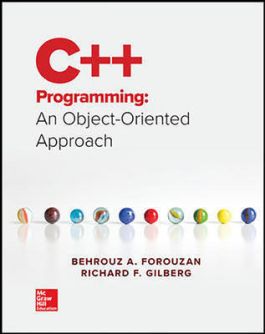EBOOK C++ Programming 1e
- Note: the eBook does not include access to Connect
- Access the eBook anytime, anywhere: online or offline
- Create notes, flashcards and make annotations while you study
- Full searchable content: quickly find the answers you are looking for
Chapter 1: Introduction to Computers and Programming Languages
Chapter 2: Basics of C++ Programming
Chapter 3: Expressions and Statements
Chapter 4: Selection
Chapter 5: Repetition
Chapter 6: Functions
Chapter 7: User-Defined Types: Classes
Chapter 8: Arrays
Chapter 9: References, Pointers, and Memory Management
Chapter 10: Strings
Chapter 11: Relationships among Classes
Chapter 12: Polymorphism and Other Issues
Chapter 13: Operator Overloading
Chapter 14: Exception Handling
Chapter 15: Generic Programming: Templates
Chapter 16: Input/Output Streams
Chapter 17: Recursion
Chapter 18: Introduction to Data Structures
Chapter 19: Standard Template Library (STL)
Chapter 20: Design Patterns
Appendices
Appendix A: Unicode
Appendix B: Positional Numbering System
Appendix C: C++ Expressions and Operators
Appendix D: Bitwise Operations
Appendix E: Bit Fields
Appendix F: Preprocessing
Appendix G: Namespaces
Appendix H: Ratios
Appendix I: Time
Appendix J: Lambda Expressions
Appendix K: Regular Expressions
Appendix L: Smart Pointers
Appendix M: Random Number Generation
Appendix N: References
Appendix O: Move versus Copy
Appendix P: A Brief Review of C++ 11
Appendix Q: Unified Modeling Language (UML)
Appendix R: Bitset
Glossary
Index
C++ Programming: An Object-Oriented Approach has two primary objectives: Teach the basic principles of programming as outlined in the ACM curriculum for a CS1 class and teach the basic constructs of the C++ language. While C++ is a complex and professional language experience shows that beginning students can easily understand and use C++.
C++ Programming: An Object-Oriented Approach uses a combination of thorough well-ordered explanations and a strong visual framework to make programming concepts accessible to students. The authors stress incremental program development wherein program analysis is followed by building a structure chart constructing UML flow diagrams writing algorithms undertaking program design and finally testing. This foundation combined with a focus on the benefits of a consistent and well-documented programming style prepares students to tackle the academic and professional programming challenges they will encounter down the road with confidence.

